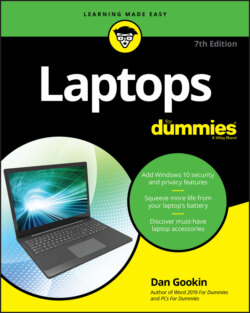Читать книгу Laptops For Dummies - Dan Gookin - Страница 50
Removing the laptop from the box
ОглавлениеLaptops, like all computers, come with lots of bits and pieces. Some of that stuff isn't junk, and you want to keep it for as long as you own the laptop. Other stuff is junk, and you can throw it away. The problem: It's difficult to determine what's worth keeping and what to toss. My advice is to keep everything for now.
Here's a handy way to approach this unpacking and pre-setup stage of your laptop's introduction to your lap:
1 Unpack the laptop.Remove the laptop from any plastic bag or shrink-wrap. Don't worry about opening the laptop's lid yet (though the temptation may be great). Just set the thing on a table by itself. When you do this, say “There.”
2 Find all the various hardware pieces that came with the laptop.Primarily, look for the power adapter and power cord. If your laptop came with only these scant items, wonderful.Secondarily, locate the battery (if it’s not installed), extra batteries (if any), cables, connectors, weird and tiny gizmos that you'll probably lose eventually, and other mystery junk. A handy trend for many manufacturers is to include a computer road map with the laptop. It’s often the first thing you find when you open the box. Unfold the map to see a visual guide to your laptop, including setup directions.
3 Make a pile for all the paperwork.Separate the product keys, manual, warranty, special offers, and weird piece of paper, the importance of which cannot be determined. Most important are the product keys, which help install or activate any software that comes with the laptop. The manual, if one exists, is so brief as to be a joke.
4 Place all packing material back into the box.This material includes plastic bags, twist-ties from the cables, and those silica pouches they tell you not to eat (probably because the stuff inside would give you superhuman powers).
Later, after your laptop is all set up and you're starting to become familiar with it, you can further organize the detritus from the box. As you work, you need to keep various items with the laptop at all times — for example, the power cord, extra batteries, and other objects, depending on how you use the laptop. You need a place, such as a laptop case, for those items.
Other stuff that comes with your laptop you might want to keep for as long as you own the laptop, such as any manuals or documentation. These things need not be kept with the laptop all the time, so storing them in a drawer or on a shelf is okay.
Only after using the laptop for a while should you consider throwing stuff away, such as the special-offer cards you don't need. Oftentimes, you can just toss those things in the laptop box. See the next section to find out what to do with the box.
If the laptop comes with a how-to manual, consider yourself lucky. Most laptops have no how-to material whatsoever.
Sometimes, the only manuals that come with the laptop are directories listing the locations where you can get it fixed. Sometimes, this material is in English.
Don’t lose the product keys!
See Chapter 13 for information on finding the best laptop bag. Even though your laptop may come with a genuine imitation-leatherette case, you want to see what else is available.
I have a shelf in my office where I store important material that comes with every computer I own. Each one has its own container, and each container holds all the stuff that came with the computer that I want to keep: spare parts and manuals and other documentation. I suggest that you have a similar shelf or location for a container or special box for your laptop’s extra stuff. Or throw it all in the everything drawer. I won’t judge you.
